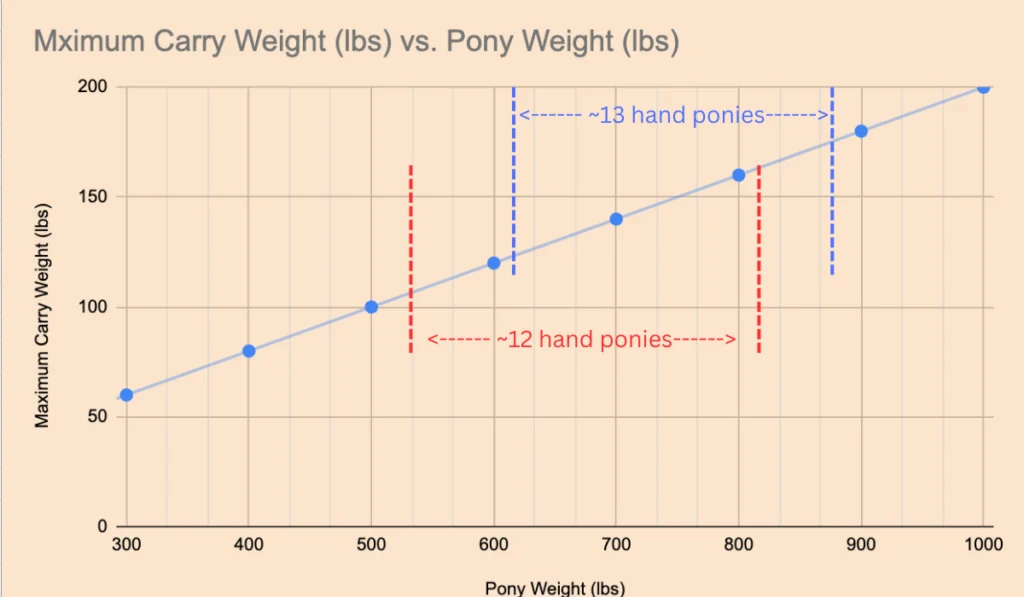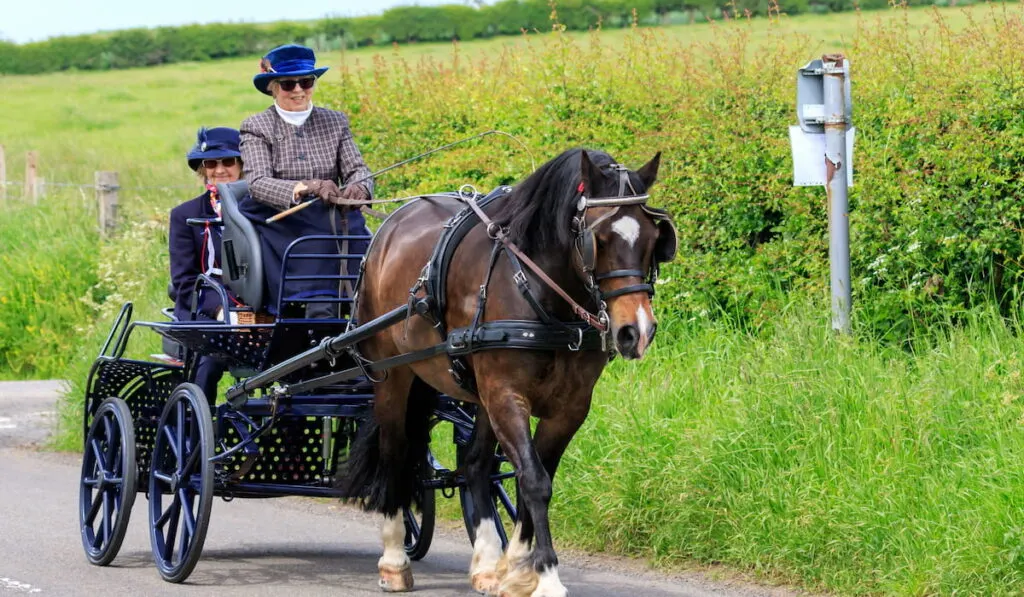A pony (or horse) shouldn’t carry more than 20% of its weight. This rule of thumb can flex a little bit: a skilled rider can weigh a bit more, so long as they have good handling of the pony. The load should be balanced to avoid straining the pony.
The weight a pony can carry also depends on the pony’s level of fitness and the amount of work required (how far it will carry the load). We’ll cover the basics before addressing how you can figure out how much your pony can carry below, before offering some more tips for riding and carrying loads on your pony.
Table of Contents
Key Takeaways
- As a rule of thumb, a pony can carry a maximum of 20% of its own weight, including rider and all equipment. This typically means a rider between 80-160 lbs can ride a pony with no issues.
- Rider skill–and weight balance–play a part. A light rider that can’t maintain balance may still be hard for the pony to carry.
- Rider skill–and weight balance–play a part. A light rider that can’t maintain balance may still be hard for the pony to carry.
- Your pony’s weight and fitness should both be taken into account when deciding how much it can carry.

The 20% Rule For Pony Carry Weight

Many equestrians follow the 20% rule of thumb. They believe that a horse or pony can safely carry up to 20% of their body weight. In the chart above, you can use the weight of your pony to find the maximum carry weight by finding the pony weight along the bottom and tracing up to the blue line.
This figure is somewhat backed by historical evidence – old US Army specifications dictate that “American mules can carry up to 20 percent of their body weight (150 to 300 pounds) for 15 to 20 miles per day in mountains” (source).
A mule (which is a particularly strong cross between a horse and a donkey) is often used as a pack animal and is well-suited for carrying heavy loads. Horses, mules, donkeys, camels, and oxes are often used as pack animals as well, but they’re meaningfully different from ponies (have a looke at our article on horses, ponies, and minis for more on this).

How Much Weight Can a Pony Carry? It’s Math!
Horses and ponies range in size and weight, just like people. On average, a pony between 9 and 14 hands may weigh between 400 and 800 pounds.
Following the 20% rule, this means that a pony can generally carry a person (including tack) who weighs between 80 and 160 pounds. This is why ponies are usually ridden by children, or smaller adults.
An exceptionally tall and stocky pony that weighs 1,000 pounds or more could probably handle a 200-pound load, but most ponies fall below this threshold.
How Much Weight Can a Ponies Carry in Kilograms?
For readers who prefer metric measurements, here are some key weight examples converted from pounds to kilograms:
- General Carrying Capacity: Ponies can typically carry 10-20% of their body weight. For a pony weighing 400 pounds (about 181 kg), this means it can carry between 40 to 80 pounds (approximately 18 to 36 kg). For a pony weighing 800 pounds (around 363 kg), the carrying capacity would be between 80 to 160 pounds (roughly 36 to 73 kg).
- Shetland Ponies: Despite their small size, Shetland ponies are strong and can often carry over 100 pounds (about 45 kg) on their backs.
- Larger Ponies: For a pony that weighs 1,000 pounds (approximately 454 kg), the carrying capacity could be up to 200 pounds (about 91 kg).

The Science of Weight (Pony Weight Limit)
Horses and ponies were first domesticated to be useful beasts of burden, transporting people and goods on their backs for hundreds of miles.
Scientific studies have shown that added weight puts stress not only on a pony’s back, but on the rest of his joints as well. The heavier the load, the higher the stress – and the higher the likelihood of injury. (source)
Imagine if you suddenly decided to go backpacking, with no training or preparation. Throwing a heavy backpack on your back and climbing miles of steep trails would probably result in some soreness or injury, no matter what your fitness level. The same is true for ponies.
A pony of any breed who is in poor condition will not be able to carry the same amount of weight as a stocky pony with a high level of fitness for the task.
You should always make sure your pony is sound and ready for work, and build him up gradually for the tasks he’s being asked to do. After all, you wouldn’t try to lift heavy weights in the gym without training first, would you?

10% Maximum for Peak Performance
There’s a reason that Thoroughbred jockeys weigh so little, and why children serve as jockeys for the Shetland Grand National. The smaller the rider, the more likely it is that the pony can perform at peak levels.
In fact, one British study suggests that riders who weigh more than 15% of their horse’s weight could be causing serious damage to the horse’s joints. (source)
However, most equestrians are not seeking to become national champions in their chosen sport. While riders should be mindful of their size, the size of their mount, and the activities they’re asking him to do, a rider’s weight is only one factor to consider.
A pony’s welfare should always be paramount. Riders should be smart, exercise caution, and not overload their ponies. Once a child has outgrown his beloved steed, it’s time to find him a horse who can carry him.
Ponies are Strong for Their Size
Despite their small stature, ponies are surprisingly strong for their size, a characteristic that is pivotal when considering how much weight can ponies carry. This strength varies based on factors like breed, workload, fitness, and temperament, essential considerations for those wondering how much a pony can carry or how much weight can a pony pull.
Many pony breeds developed in mountainous regions, carrying heavy loads of goods up and down steep trails.
Shetland ponies are some of the smallest equines in the world – but they’re also some of the strongest. Shetland ponies can often pull more than twice their body weight, and carry over 100 pounds on their backs. (source)
For more on the fascinating Shetland Pony, have a look at our Shetland Pony breed profile and this write-up of 17 intersting facts about the Shetland Pony.
Best/Strongest Pony Breeds
A pony is technically classified as a small horse that stands below 14.2 hands high at the withers.
A heavy draft-cross pony may be capable of carrying more weight than a slender Thoroughbred or Arabian cross, but some breeds are known for being exceptionally strong for their size:
- Welsh Ponies: Known for their riding and driving, capable of carrying significant weight relative to their size. Have a look at our article on Welsh Pony’s & Cobs for more on this.
- Shetland Ponies: Despite their diminutive size, Shetland ponies are incredibly strong, and often able to pull weights much heavier than themselves. normal pony weight limits can be stretched a bit for Shetlands, which is impressive.
- Dartmoor Ponies and Exmoor Pony: Both breeds are noted for their hardiness and strength. Originating from rugged British landscapes, these ponies are accustomed to challenging terrains, making them ideal for a variety of equestrian activities.
- Chincoteague: This breed, while not as widely known as others, has shown considerable resilience and strength.

Riding Weight Limits
Small horses or large ponies may be capable of carrying a larger person, but it depends on the kind of work they’re being asked to do. Plenty of strong ponies could handle an occasional trail ride at a slow speed or short rides around a flat arena.
Heavier riders who wish to ride their horses regularly, or participate in more strenuous events (such as show jumping or eventing) should consider a heavier mount.
Many riding programs (especially tourist-based trail riding programs) have weight limits of around 200 – 250 pounds, for the safety of their riders and their horses. However, these are generally full-sized horses or mules that are used to carrying heavier loads.
Theoretically, a strong and stocky pony that reaches over 1,000 pounds should be able to carry a 200-pound person – but remember, that’s also including tack or any extra baggage as well.

Pony Club Weight Limits
The United States Pony Club has specific rider weight limits for their mounted games – a rider may not weigh more than 18% of their pony’s approximate weight. However, these ponies are often horse-sized and capable of carrying small adults.
The Polocrosse games have similar weight requirements. The following weight limitations apply to riders dressed and ready to ride:
- Riders of ponies 12.2 hands or under may not weigh more than 117 pounds.
- Riders of ponies 12.3 – 13.2 hands may not weigh more than 150 pounds.
- Riders of ponies 13.3 – 14.2 hands may not weigh more than 190 pounds.
- Riders that exceed 190 pounds may not participate. (source)
Limits Used Frequently Around The World
India’s rules for the prevention of cruelty to draft and pack animals dictate that the maximum weight for mules is 200 kg (440 pounds), and the maximum weight for ponies is 70kg (154 pounds).
In Iceland, small Icelandic horses were limited to 100kg (or 220 pounds). However, this guideline was for pack animals that moved heavy loads at a walk.
Many modern studies have indicated that any load heavier than 30% of the animal’s body weight is likely detrimental in the long run.

How Much Weight Can A Pony Pull In A Cart?
Many adult pony-enthusiasts prefer to drive their ponies instead. Because ponies are generally strong for their size, many were bred specifically for this purpose. Shetland ponies were bred to pull heavy coal carts in coal mines with low ceilings, and they make excellent driving ponies.
If you’re interested in driving your pony, consider the following pony breeds (source):
- Hackney Pony
- Shetland Pony
- Welsh Pony
- Dartmoor Pony
- New Forest Pony
- Fell Pony
- Standardbred / Saddlebred / Morgan x Pony cross
While there is no hard and fast rule about how much weight a pony should carry, equestrians should use their heads. If a pony is cheerful, willing, and sound after a long day of carrying a heavier load, then he may be suited for the work. Here are some general recommendations for weight pulled in a cart:
General Guidelines for Weight Pulled in a Cart
- Deadweight vs. Wheeled Carts: When pulling deadweight (without wheels), ponies can typically pull no more than 10% of their body weight. However, if the weight is on a wheeled cart, this capacity increases significantly. Ponies can generally pull up to 1.5 times their body weight over long distances if the load is wheeled. (Source)
- Shetland Ponies’ Exceptional Strength: Shetland ponies, known for their remarkable pulling strength, can pull up to twice their body weight. This capacity is especially notable given their small size compared to other pony breeds. (Source)
- Terrain and Conditions: The ability to pull a certain weight also depends on the terrain and conditions. Ponies might pull heavier loads on flat and smooth surfaces compared to rough or hilly terrain.
- Health and Welfare: As with carrying weight, the health and welfare of the pony should always be a priority. Ensuring that the pony is not overworked or overloaded is crucial for its long-term health and well-being.
How Much Weight Can Various Types of Ponies Pull In A Cart?
- 12 Hand High (12hh) Ponies: These ponies typically weigh between 530 and 815 pounds. Based on their strength and body weight, they can pull significantly more than they can carry. While exact figures vary, a 12hh pony could potentially pull a cart weighing up to double its body weight, meaning anywhere from approximately 1060 to 1630 pounds, depending on the specific pony and conditions. But only if you pay attention to its behavior and watch to make sure it’s not strained or overtired.
- 13 Hand High (13hh) Ponies: Slightly larger, 13hh ponies usually weigh between 620 and 880 pounds. Similar to 12hh ponies, they can also pull a cart weighing about double their body weight. This means a 13hh pony might be capable of pulling a cart weighing roughly 1240 to 1760 pounds.
- Shetland Ponies: Known for their remarkable strength relative to their size, Shetland ponies can often pull up to twice their body weight. As they are one of the strongest pony breeds, a Shetland pony can potentially pull a cart weighing significantly more than an average pony of the same size. This capability stems from their historical use in pulling heavy coal carts in mines.
Frequently Asked Questions (FAQ)
How Much Weight Can A Power Pony Carry?
A power pony, like this one, is a toy for children (or perhaps overzealous adults) to ride on! These toys, like this Powerpony Ride On Unicorn Hoverboard (on Amazon), have their own weight limits – refer to the manufacturer’s instructions! If you know of a young horse enthusiast who may enjoy one of these, have a look at our artiel on the 11 Best Ride-On Unicorn Toys.


